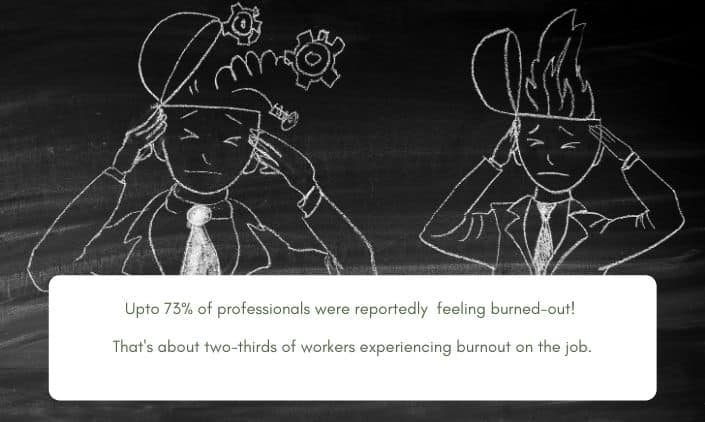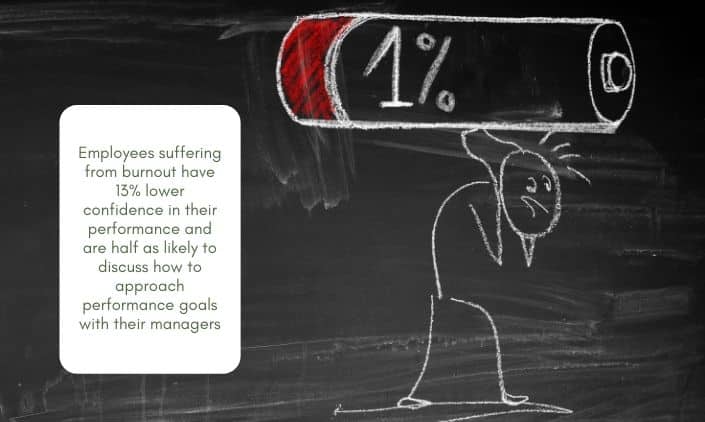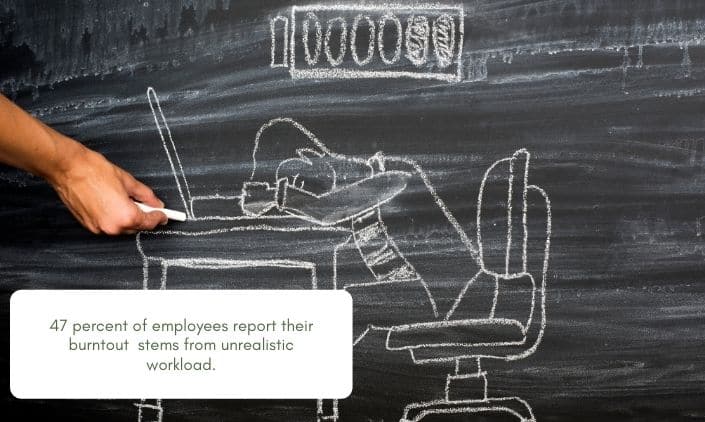
You used to think that working from your bed in pajamas and cozy clothes was the real perk of WFH. Cuddling up with your pet while still on a work call sounded dreamy.
So what if you start your day still in bed or couch, opening the laptop for a quick mail, then switching windows to catch the new episode of your favorite web series, do some work, grab your lunch while sitting through a conference, and work some more?
What if it’s later in the evening before you know it? What if you feel your day wasn’t productive enough so you try to work late-night, wanting to make up for the day? And what if your laptop has become an extension of yourself, always by your side?
The lines between work and not-work is blurred and your professional and private life is fused so tightly together that it’s beyond recognition. Sounds familiar?
15 hours a week! That’s the average time an employee reports to be working extra since the pandemic forced us all to to take the work home and remote work flourished. That’s 3 hours every.single.day.
With more work and less separation between your private and professional life, exhaustion, occupational stress, and burnout creeps up on you. The pandemic has been directly linked to growing work stress, and as it happens, burnouts.
Last week, we wrapped up the Spring edition of our XDay MENA 2021, themed ‘Advancing Experiences’. We hosted Psychiatrists and mental health experts as well as HR leaders and key-decision makers of businesses in the Middle East to come togetehr and discuss how the pandemic fatigue has affected the workforce. It was an illuminating virtual event highlighting the acute crisis of burnout and what we, as the leading businesses and industry experts of the region, can do to tackle this. Do catch all the updates in the recordings we’ll post in QuestionPro Youtube channel, if you missed the event.
So what is burnout? Workplace stress, when left unmanaged, becomes burnout. It is essentially a chronic form of fatigue, one that you won’t be able to shake off, one that wouldn’t budge by taking a vacation.
Part 1: What causes burnouts?
Chronic stress causes burnouts. When you are mentally stretched for too long and you see no light at the end of the tunnel, you are likely to suffer a burnout.
To put things in perspective, while burnout still hasn’t made its way into the popular lingo, some reports suggest that as many as 73% of the workforce has suffered burnouts at some point.

The pandemic has acted as a strong catalyst in inducing burnouts. This is partly because people were forced to learn on the fly and abandon their comfort zones and old habits.
Employees are soon realizing that what used to work for them at the start of the Covid has stopped being helpful. They are also trying to fit their entire lives – personal, professional, social- in a space they didn’t previously use for all those aspects.
A combination of work stress, a prevalent sense of helplessness and uncertainty, fear of job-loss, work-from-home challenges, unmanageable workload, and financial worries has together contributed to a never-before onset of burnout during these Covid times- made worse by each day as we all realize we are nowhere close to the end.
People confess they feel the need to answer a work email or a text from the coworker even if it’s way past their office hours. It’s increasingly difficult to separate work life from home life, and the likelihood of an eventual burnout is simply too high.
The feeling of constantly being “on” and the inability to disconnect can make people feel exhausted—physically and emotionally. Often they feel like they can’t think about anything but work, so they stop doing things they enjoy.
On top of all this, social isolation makes matters worse. Employees admit to feeling like they have no one to turn to, and co-workers fail to notice subtle shifts in their stress-driven behaviour.
People are overworked and exhausted- there is no getting around that fact- and the pandemic is taking its toll in the workforce. Boundary-crossing is the new normal, and the honeymoon phase of WFH is over. Employers are discovering exactly what the earlier spike of productivity cost them (brought on by the onset of remote working). People have bitten off more than they could chew, it seems, and employers weren’t adequately informed what to expect.
Going back to the original statistics, employees and employers alike are realizing the price of that extra 15 hours of work a week!
Part 2: What are the symptoms of a burnout?
We’ve discussed how chronic stress leads to a burnout. But how do you recognize a burnout when you suffer one?

Our brains switch into ‘survival mode’ at a heightened state of continuous stress, and survival mode just doesn’t have any room for ambition or responsibility.
Things stop mattering so much- especially stuff like messages, notifications, deadlines, and projects. Burned out individuals are more prone to procrastinating on projects and avoid work altogether. People report feeling ‘frazzled and sleep-deprived’, and often can’t stop worrying about work, despite lacking the drive and motivation to actually do work. Here’s a list of the most common symptoms peopel experienec when they are going through a burnout:
- Losing track of tasks and having trouble concentrating
- Not completing work on time, reduced professional efficacy
- Going through mood changes like irritability, sadness, or anger
- Experiencing symptoms of depression, like hopelessness, loss of interest in things you used to enjoy, or fatigue
- Feeling discouraged or apathetic about work, lacking motivation
- Getting poor sleep, experiencing insomnia, or having trouble falling asleep
- Drinking more alcohol than normal, or drinking to cope
- Experiencing physical symptoms like chest pain, headaches, increased illness, heart palpitations, dizziness or fainting, or gastrointestinal pain
- Feeling irritation, anger, or in denial
- Feeling uncertain, nervous, or overwhelmed
- Feelings of energy depletion or exhaustion
- Increased mental distance from one’s job, or feelings of negativism or cynicism related to one’s job
Recognizing burnout is key to address the root cause, identify the triggers, and to keep the damage minimal. One of the major red flags of burnout is persistence; the exhaustion from burnout runs deep and doesn’t go away fast.
Part 3: How can you keep burnout away?
To take time off is the first and impulsive way to remedy a burnout. And a change in scenery is much appreciated and not without merit. However, we should understand that burnout is often a cycle and chronic condition, one that shan’t go away permanently until you change the working conditions that caused it in the first place.
* Find work-time budgets that works for you
People work best at different times and they need to have the flexibility to choose their work time while working from home. Other matters of importance like cooking dinner, or children’s nap time can keep a person from being ‘on’ all the time, and it helps to respect those situations.
Employees should be comfortable letting their team know that they might be slower than usual in responding during these budgeted timeslots, to keep the employee expectations reasonable.

* Establish firm work/life boundaries
Practice self awareness so you can transition from ‘home-you’ to ‘work-you’. Something obvious like getting a door to your home office that can be shut during work hours, and turning email and work notifications off while you are having dinner with the family can do wonders to your work-life balance. Implementing office hours, activating OOO responses, and establishing a healthy WFH lifestyle can go a long way in keeping the burnouts away.
* Control only the controllables
There is only so much you can change or control about the uncertainty of the pandemic. The stress and anxiety is expected. What you can change though, is your routine and lifestyle.
It’ll do your system tons of good to have a healthy routine- perhaps replace what used to be your daily office commute with a walk to the park. Make it non-negotiable to have your lunch and dinner away from your computer. Exercise consistently and set some time apart for a hobby that relaxes you. The goal is to set up systems so that your brain knows the signals for when it is time to work and when it is time to switch off and relax.
At the end of the day, what counts is if you establish boundaries for yourself and honor them.
Part 4: What can employers do to support their people?
Offering social support in the workplace is a powerful way to reduce stress and burnout among employees. Just because you don’t all work from the same office structure anymore doesn’t mean that you have to say goodbye to the office friendships and free-flowing conversations.
* Create remote ‘water-cooler’ time
QuestionPro went fully remote since the pandemic, having adopted a Work-From-Anywhere policy. To keep the conversations happening and avoid social isolation, my team gets on weekly fun group calls- just to hang out together and discuss what’s been going on in each other’s lives. It’s a great way to check in and be there for each other. Set up similar ‘water cooler’ time regularly with coworkers. Or if it can be arranged, socially distanced meet ups can be magical too!
Added benefit of checking on others is that it also makes you feel great- it improves your own sense of control, belonging, and self-esteem.Talk about win-win!
* Provide mental health benefits
A wholesome healthcare plan, covered gym/health club membership, or reimbursing meditation apps are great ways to walk the talk about employers caring for the mental health and wellbeing of their people.
A great many companies have stepped up to offer mental health benefits that they didn’t provide before the pandemic, including telemedicine screening and employee assistance programs.
* Ensure realistic workloads
Survivors of burnouts often point out unreasonable expectations and overwhelming workload as a main contributing factor. When work never gets done despite all the extra hours employees put in, it highlights a deeper issue- the workload is too much. The obvious cure is to distribute the load evenly with more resources and take the brunt off your workforce’s shoulders.

Regularly monitor workloads and trak common signs of burnout (exhaustion, anxiety, inability to keep up with daily tasks) to find out when it’s time to dial back demands and expand resources.
* Encourage vacations and flexibility
The organic way of increasing employee productivity is not by requiring overtime. It is by allowing employees to rest and regenerate. Be vacation-friendly, and replace micro-managing by awarding employees at least some level of control over their schedule.
* Empathetic leadership
Companies risk harming their bottom line and brand when they ignore the alarming rates of employee burnouts during the pandemic. Exhausted employees and burnouts can deeply affect the productivity levels, employee engagement, job satisfaction, and retention rates.
As a company, you cannot really diagnose an employee’s burnout for them. However, you can acknowledge the issue, and empower a culture of empathy and ample communication so that your employees are encouraged to care about their emotional wellbeing. And also, know when something is amiss.
If your work culture is that of employee trust, they’re much more likely to realize their stress and burnout symptoms and reach out to you for support. Ensure you have an employee experience management program to understand issues and address them.
LEARN ABOUT: Employee Care
There is nothing better you can do for your people than letting them know it is okay to have problems. Offer them space to be forthcoming and seek support. Have a systemic support system in place and ensure your employees are aware of what resources exist to help them cope during difficult times.







